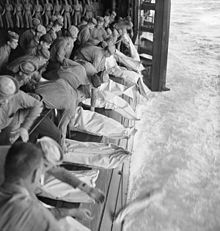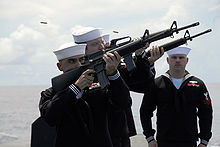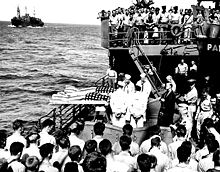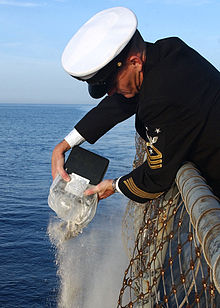- Burial at sea
-
Burial at sea describes the procedure of disposing of human remains in the ocean, normally from a ship or boat. It is regularly performed by navies, but also can be done by private citizens in many countries.
Contents
By religion
Burial at sea services are available at many different locations and with many different customs, either by ship or by aircraft. Usually, either the captain (or commanding officer) of the ship or aircraft or a representative of the religion performs the ceremony.
The ceremony may include burial in a casket, burial sewn in sailcloth, burial in an urn, or scattering of the cremated remains by ship. Burial at sea by aircraft is usually done only with cremated remains. Other types of burial at sea include the mixing of the ashes with concrete and dropping the concrete block to form an artificial reef such as the Atlantis Reef.
Below is a list of religions in alphabetical order that allow burial at sea, with some details of the burial. However, there are always many different beliefs even within the same religion, and views may differ according to those beliefs.
Buddhism
There are very few traditional Buddhist burials at sea. Traditionally, the deceased are cremated and the ashes are placed in a grave or columbarium. Particularly in East Asian or Mahayana Buddhism, a physical gravesite is considered important for the conduct of memorial and ancestor rites. The Buddhist Churches of America, the North American branch of Japanese Jodo Shinshu Buddhism, has created a service for Buddhist burials at sea, primarily for military service members.
Christianity
Catholicism
Officially, the Roman Catholic Church prefers normal casket burials over cremations, but does allow for cremation subject to the condition that the ashes are entombed or buried. It is not proper to scatter or pour the cremated remains over the sea, water, or on the land. According to the Roman Catholic Church this action does not give due respect to the remains of the deceased, nor does it allow for the closure and healing of family and friends. Likewise they see that the housing the remains with family or friends and not placing the deceased in the ground, does not offer loved ones a specific and sacred place to visit the individual. Visiting the deceased in a holy place provides believers with a space to offer prayers, commune with the those who have gone before them in faith, and reminds them to await the resurrection of their own bodies. Burial at sea in a casket or in an urn is approved for cases where the deceased expired in the sea. The committal prayer number 406§4 is used in this case.[1]
Reformed/Protestantism
The Anglican Communion has detailed procedures for burial at sea. The ship has to be stopped, and the body has to be sewn in sailcloth, together with two cannon balls for weight.[citation needed] Anglican (and other) chaplains of the Royal Navy bury cremated remains of ex-Naval personnel at sea. Scattering of cremated remains is discouraged, not least for practical reasons.
Many Lutheran naval veterans and seamen prefer to be buried at sea. In those cases either the casket or urn is set to sea, or ashes scattered. The procedure is similar as that with Anglican. Some parishes have specific consecrated sea areas, where ashes can be sprinkled.
Hinduism
Traditionally, the deceased are cremated, the bones and ashes are collected, and the ashes/remains are immersed in the Ganges River if possible or in any other river if not.
Islam
The sacred texts of Islam prefer burial on land, "so deep that its smell does not come out and the beasts of prey do not dig it out". However, if a person dies at sea and it is not possible to bring the body back to land before decay, or if burial at land becomes impossible, burial at sea is allowed. A weight is tied to the feet of the body, and the body is lowered into the water. This would preferably occur in an area where the remains are not immediately eaten by scavengers. Also, if an enemy may dig up the grave to mutilate the body, it is also allowed to bury the deceased at sea to avoid mutilation.[2]
In the Sunni Fiqh book Umdat al-Salik wa Uddat al-Nasik, the condition for sea burial is:
- It is best to bury him (the deceased) in the cemetery... If someone dies on a ship and it is impossible to bury him on land, the body is placed (O: tightly lashed) between two planks (O: to obviate bloating) and thrown into the sea (O: so that it reaches shore, even if the inhabitants are non-Muslims, since a Muslim might find the body and bury it facing the direction of prayer (qibla)).[3]
But others disagree:
- [A]fter giving Ghusl, Hunut, Kafan and Namaz-e-Mayyit it should be lowered into the sea in a vessel of clay or with a weight tied to its feet. And as far as possible it should not be lowered at a point where it is eaten up immediately by the sea predators.[4]
Judaism
Traditionally, Judaism has required prompt burial in the earth.[5]
By country
Australia
Burial at sea within Australian territorial waters, exclusive economic zone and continental shelf is covered by the Environmental Protection (Sea Dumping Act) 1981 administered by the federal Department of the Environment. A permit is required for burial of bodies at sea. Permits are usually only granted in cases of a strong connection to the sea, for example long serving navy personnel. The body must not be embalmed or placed in a casket, it may only be sewn into a weighted shroud. The burial must be in water deeper than 2,000 metres (6,600 ft) and not interfere with shipping, fishing or undersea communications. Australian Defence Force vessels engaged in armed conflicts or emergency situations are exempt from these requirements.[6]
No permit is required to scatter ashes at sea.
United States
A funeral director is not required for the burial of cremated remains at sea; however full body burials require specific preparation to ensure that the body or coffin sinks quickly. California is the only U.S. State that does not permit full body burials within their territorial waters (which extends 3 miles from shore, Yet 3.1 miles offshore or greater is considered US Territorial Waters and hereby it is legal). The Environmental Protection Agency regulations for full body burials at sea in the United States require that the site of interment be three (3) nautical miles (3.5 mi / 5.6 km) from land and at a depth of at least 600 feet (180 m). In the northeastern United States this may require travel in excess of 30 miles (48 km) for a suitable site.[7]. Santa Barbara, CA. is one of the few places in the country, where this service can be conducted within relatively calm water, meet the 3 mile offshore rule and achieve the depth required.
The United States Navy has performed many burials at sea in its history, with wartime burials as recently as World War II, and peacetime burials still common. Most other armed forces also perform burials at sea, such as the British Royal Navy and the Canadian Navy.
If the deceased died on land or has been returned to shore after death, the remains may be brought aboard either in a coffin or in an urn after cremation. The ceremony is performed while the ship is deployed, and consequently civilians are not allowed to be present. In the USA, people eligible for a free Navy burial at sea are:
- Active-duty members of the uniformed services
- Retirees and honorably discharged veterans
- Military Sealift Command U.S. civilian marine personnel
- Family members of the above
In preparation, the officer of the deck calls All hands bury the dead, and the ship is stopped (if possible). The ship's flags are lowered to half mast. The ship's crew, including a firing party, casket bearers and a bugler, are assembled on the deck. The crew stands at parade rest at the beginning of the ceremony. The coffin is covered with a flag, and is carried feet first on deck by the casket bearers. The casket is placed on a stand, with the feet overboard. In case of cremated remains, the urn is brought on deck and placed on a stand.
The ceremony is divided into a military portion and a religious portion. The religious part is specific to the religion of the deceased, and may be performed by a Navy chaplain, or by the commanding officer if no chaplain of the appropriate faith is available. A scripture is read and prayers are said.
After the religious ceremony, the firing party is ordered Firing party, present arms. The casket bearers tilt the platform with the casket, so that the casket slides off the platform into the ocean. The flag which was draped over the casket is retained on board. For cremated remains, there is the option to bury the remains using the urn in a similar fashion to the procedure used for caskets. Alternatively, the urn can be opened, and the remains scattered in the wind. In this case, the wind direction has to be taken under consideration before burial to ensure a smooth procedure.
The firing party fires a three volley salute, the bugler plays Taps, and flowers may also be dropped into the ocean. After the flag is folded, the ceremony ends. The relatives will be informed of the time and location of the burial, and given photos and video recordings if available.
United Kingdom
Burial at sea was a method hypothetically suggested by the then Medical Officer of Health for Liverpool, Dr Duncan Dolton, in which unburied bodies could be buried at sea during any extended strike by gravediggers union the GMWU during the Winter of Discontent. The suggestion caused great alarm amongst the public and helped prompt a resolution to the strike.[citation needed]
Wartime burial for deceased at sea
 Burial at sea for the casualties of the USS Intrepid, hit by Japanese bombs during operations in the Philippines, November 26, 1944
Burial at sea for the casualties of the USS Intrepid, hit by Japanese bombs during operations in the Philippines, November 26, 1944
 Navy firing detail as part of a burial-at-sea in 2008 for one of the 316 survivors of the USS Indianapolis (CA-35) sinking on July 30, 1945, during World War II.
Navy firing detail as part of a burial-at-sea in 2008 for one of the 316 survivors of the USS Indianapolis (CA-35) sinking on July 30, 1945, during World War II.
In wartime, attempts are made for burial at sea to follow the same procedure as in the peacetime burial at sea, although a ship on a combat mission may not have all the necessary resources available. Nowadays, it is usually possible to airlift the remains back to shore, and prepare a burial ceremony. However, as recently as World War II, deceased were buried at sea without returning to land. Due to the limited facilities of military ships, this procedure usually does not include a casket, but the body is sewn into a sailcloth with weights, usually rocks or cannonballs.[8] Cremation is usually not possible on a ship. During the Pacific campaign there were some instances where deceased aircrews were buried at sea in the remains of their damaged aircraft, which were ceremonially pushed overboard from their aircraft carrier[9]
Memorial services at sea
If no remains of the deceased are available a memorial service may be held, and flowers may be dropped in the water, often over or near the location of the death.
People buried at sea
Main article: List of people buried at seaA few notable burials at sea:
- Sir Francis Drake (1540–1596) (body in lead coffin off the coast of Portobelo, Panama)
- Edward Winslow (1595 – 1655) (buried at sea near Jamaica on 8 May 1655)
- Stan Getz (1927–1991) (cremated, and ashes scattered in the Pacific Ocean off Malibu, California)
- Robert A. Heinlein (1907–1988) (cremated, and ashes scattered in the Pacific Ocean)[10]
- Doug Henning (1947-2000) (cremated, and ashes scattered into the Pacific Ocean of Redondo Beach, California)[11]
- Sir Edmund Hillary (1919–2008) (cremated, and ashes scattered in New Zealand's Hauraki Gulf)[12]
- Sir Alfred Hitchcock (1899–1980) (ashes were scattered into the Pacific Ocean)
- Rock Hudson (1925–1985) (cremated ashes scattered)
- Janis Joplin (1943–1970) (cremated at Westwood Village Memorial Park Cemetery, and her ashes scattered into the Pacific ocean)
- Dennis Wilson (1944–1983) (cremated ashes scattered in the Pacific Ocean off California)
- Leyla Gencer (1928-2008) (ashes were scattered into the Bosphorus)
- DeForest Kelley (1920–1999) (ashes were scattered into the Pacific Ocean)
- Gene Kelly (1912–1996) (cremated ashes scattered)
- John F. Kennedy, Jr (1960–1999) (scattered into the Atlantic Ocean by the U. S. Navy off Martha's Vinyard)
- Werner Klemperer (1920–2000) (cremated ashes scattered)
- Peter Lawford (1923–1984), actor, was cremated and ashes originally buried at Westwood Village Memorial Park Cemetery; they were later removed and scattered in the Pacific Ocean.
- Steve McQueen (1930–1980) (cremated and ashes scattered in the Pacific Ocean)
- Robert Mitchum (1917–1997) (cremated ashes scattered)[13]
- Vincent Price (1911–1993)[14] (ashes scattered off Point Dume in Malibu, California)
- Admiral of the Fleet Sir Alfred Dudley Pickman Rogers Pound (1877–1943) (cremated ashes scattered)
- Richard Rodgers (1902–1979) (cremated ashes scattered)
- H. G. Wells (1866–1946) (cremated and ashes scattered in the sea off England)
- Numerous RMS Titanic victims picked up by rescue ships, whose remains were too damaged to preserve or for whom the rescuers lacked sufficient embalming materials, were buried at sea
- Following the 1962 execution in Israel of Adolf Eichmann, the Nazi responsible for overseeing the extermination of millions of Jews during the Holocaust, his body was cremated and his ashes scattered at sea over the Mediterranean, in international waters. This was done in this special case since Israel did not want such a person buried in its soil, and also did not want a grave elsewhere that might have become a place of pilgrimage for other Nazis.
- Osama Bin Laden (1957–2011)[15] One U.S. official stated that "finding a country willing to accept the remains of the world's most wanted terrorist would have been difficult."[16] It was also done to prevent his burial place from becoming a "terrorist shrine".[17] Islamic funerary rites indicate that burial take place on land "deep enough so that no beast will bother the deceased." However, burial at sea is also permitted to prevent the body from being dug up and desecrated.
See also
References
- ^ NCCBUSCC.org Accessed September 3, 2010
- ^ Al-islam.org
- ^ Reliance of the Traveller, Ahmad ibn Naqib al-Misri, p 237, Translated by Nuh Ha Mim Keller, Amanah publications, ISBN 0-915957-72-8
- ^ "Rules About Burial of the Dead Body". Al-Islam.org. http://www.al-islam.org/laws/burial.html.
- ^ Shulchan Aruch, Yoreh Deah 362:1
- ^ "Environmental Protection (Sea Dumping Act) 1981". Australian Government. http://www.comlaw.gov.au/Series/C2004A02478.
- ^ Federal Register, Volume 40, Section 229.1
- ^ Francone, Patrick. "Burial at Sea: Down in Davy Jones' Locker". mysendoff.com website. mysendoff.com. http://mysendoff.com/2011/05/ocean-burial-down-in-davy-jones-locker/. Retrieved 19 October 2011.
- ^ Genforum World War II
- ^ Heinlein Society
- ^ Geniimagazine.com
- ^ "Sir Edmund Hillary takes final voyage, ashes scattered at sea". The New Zealand Herald. 29 February 2008. http://www.nzherald.co.nz/section/1/story.cfm?c_id=1&objectid=10495373. Retrieved 22 September 2011.
- ^ Robert Mitchum (1917 - 1997) - Find A Grave Memorial
- ^ Vincent Price (1911 - 1993) - Find A Grave Memorial
- ^ CBS News
- ^ Yahoo report
- ^ Osama Bin Laden Body Headed for Burial at Sea, Officials Say - The Note
Categories:- Ceremonies
- Death customs
- Naval ceremonies
- Funeral transport
- Burials at sea
- Water transport
Wikimedia Foundation. 2010.




